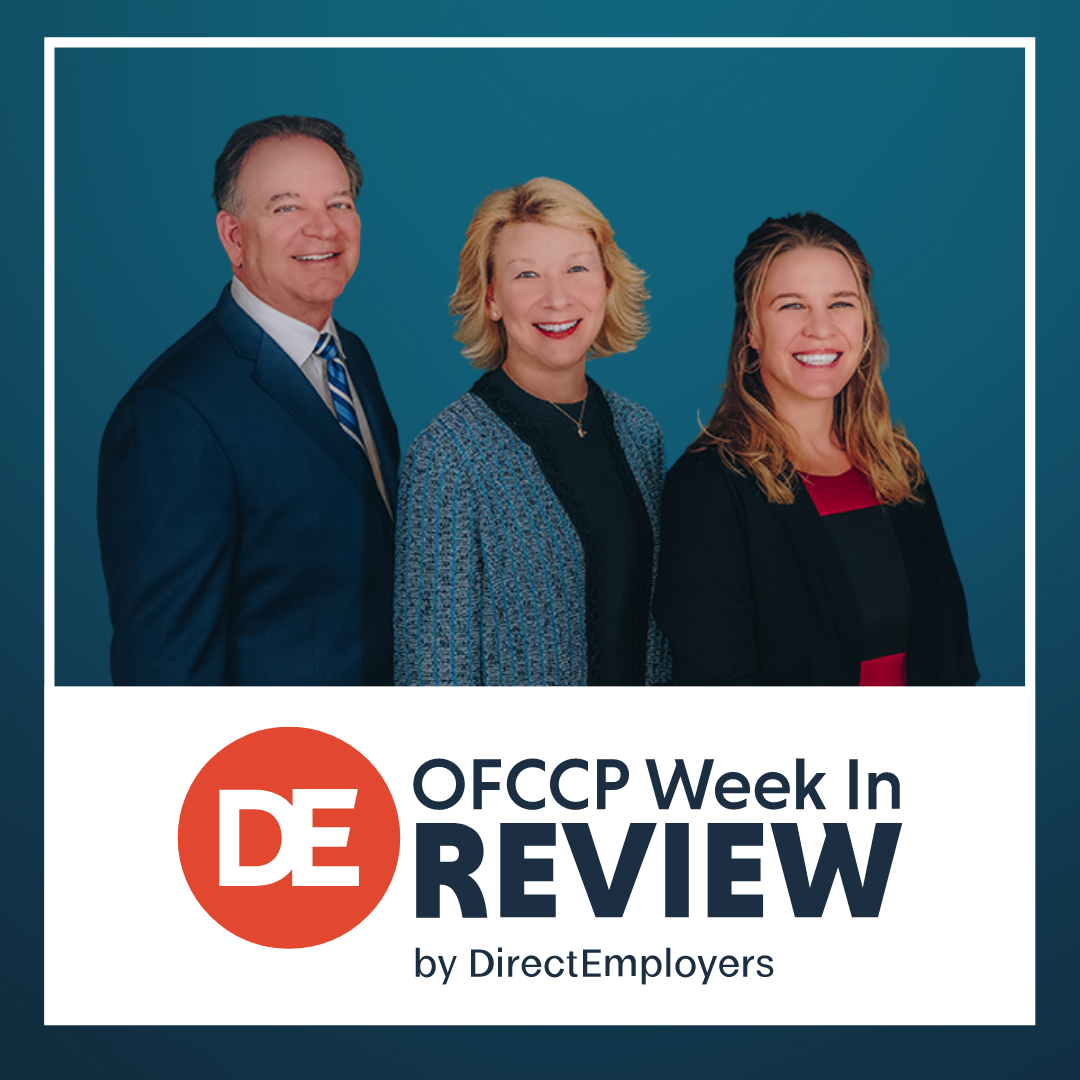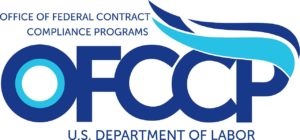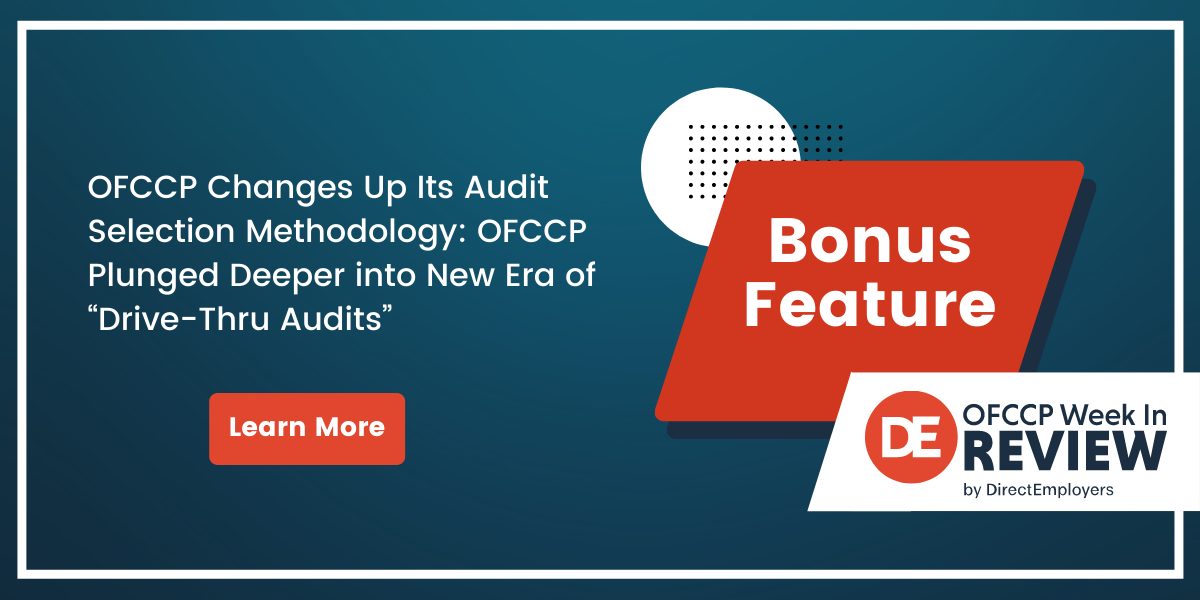 The DE OFCCP Week in Review (WIR) is a simple, fast and direct summary of relevant happenings in the OFCCP regulatory environment, authored by experts John C. Fox, Candee Chambers and Jennifer Polcer. In today’s edition, they discuss:
The DE OFCCP Week in Review (WIR) is a simple, fast and direct summary of relevant happenings in the OFCCP regulatory environment, authored by experts John C. Fox, Candee Chambers and Jennifer Polcer. In today’s edition, they discuss:
- Court Holds California State Law Requiring Female Representation on Boards of Publicly Held Companies Unconstitutional
- New Feature in OFCCP Contractor Portal Allows for Bulk Processing of AAP Establishments
- EEOC to Host LGBTQ+ Advocacy Webinar in the Post-Bostock World
- Veterans Employment, Training, and Employer Outreach Committee to Host Public Meeting
- EEOC Listened to a Powerful Panel to Aid in Ending Harassment in the Construction Industry
- National Labor Exchange Breaks Record with Four Million Job Listings Now Available on a Daily Basis!
- Fifth Circuit Case Decision Struck Down the U.S. Securities and Exchange Commission’s Entire Administrative Law Judicial System
- OFCCP Changes Up Its Audit Selection Methodology: OFCCP Plunged Deeper into New Era of “Drive-Thru Audits”
Friday, May 13, 2022: Court Holds California State Law Requiring Female Representation on Boards of Publicly Held Companies Unconstitutional

To increase female and minority representation in the governance of public corporations in California, the state passed two statutes forcing those companies to place minorities and women on their Board of Directors. First, in 2018, then-Governor Jerry Brown signed into law SB 826. That law created California Corporations Code § 301.3, requiring corporations to have a minimum number of female directors based on the size of the Board of Directors and requiring the Secretary of State to publish a report denoting which corporations complied with the new law, which companies moved their headquarters in or out of California, and the identity of corporations that altered their publicly traded status. This law also imposed monetary fines on those companies which failed to comply with the minimum representation requirements. California subsequently passed AB 979 in 2020, requiring publicly traded corporations with executive offices in California to appoint a minimum number of directors from “underrepresented communities.” “Underrepresented communities” meant individuals who self-identified as “Black, African-American, Hispanic, Latino, Asian, Pacific Islander, Native American, Native Hawaiian, or Alaska Native,” or who self-identified as “gay, lesbian, bisexual, or transgender.”
Ruling that SB 826 violated the equal protection clause of the California Constitution, Judge Duffy-Lewis held the law treated similarly situated individuals in an unequal manner based solely on their gender. First, Judge Duffy-Lewis rejected the state’s contention the lawsuit was not ripe since the state had yet to issue any penalties under the statute. Second, Judge Duffy-Lewis rejected the state’s purported “compelling interest” of “achieving gender equality or parity” as justification for state-sanctioned gender preference in hiring, holding that there is no compelling governmental interest in remedying generalized, non-specific allegations of discrimination. Finally, Judge Duffy-Lewis noted that the law was not “narrowly tailored” to the state’s reported interest to improve opportunities for women in the workplace and boosting California’s economy. Rather, she found California’s evidence regarding improved corporate governance with female representation was inconclusive. (That is significant since that is a factual finding which makes reversal on appeal much more difficult for proponents of directed-appointment quotas to corporate Boards.
The court’s ruling puts into doubt the diversity efforts of the state legislation. The state of California has yet to announce whether it intends to appeal Judge Duffy-Lewis’ ruling (as well as to whether it intends to appeal the earlier unrelated ruling in the case involving AB 979 requiring quota appointments of “underrepresented communities”). It is also unknown whether California Governor Gavin Newsom will choose instead to amend the laws in league with a supportive state legislature, where Democrats maintain a “super-majority” status capable of passing statutes over the objections of all Republican state legislators. For now, publicly held companies in California are free from the requirements and monetary fines both state statutes had sought to impose.
However, companies listed on the Nasdaq Stock Market should be aware of its potential reporting obligations as to gender, race, and sexual orientation representation on their Boards of Directors pursuant to Nasdaq Rule 5606. While Rule 5606 does not impose any minimum representation requirements, it does require public reports. The Nasdaq Rule is also the subject of legal challenge. Rule 5606 nonetheless remains in effect, however, pending oral argument in early August before the U.S. Court of Appeals for the Fifth Circuit (New Orleans) on a petition seeking judicial review of the SEC’s approval of the Nasdaq Rule.
Monday, May 16, 2022: New Feature in OFCCP Contractor Portal Allows for Bulk Processing of AAP Establishments

The Office of Federal Contract Compliance Programs (OFCCP) announced a new “Bulk Upload” feature in its Contractor Portal.
For those of you who have been stranded in orbit above the earth beyond Internet range for the past six months, the Contractor Portal is the new OFCCP platform to gather information pursuant to the agency’s “AAP Verification” Initiative. (See our story, “OFCCP’s New Emerging AAP Delivery Portal and AAP “Verification” Program: Much Ado About Nothing.”)
New Feature – Bulk Upload
Companies with 100 or more establishments or functional/business units may now request to have their establishments or functional/business units uploaded/modified in bulk by using the Bulk Upload/Modification Template.
For more information regarding the bulk upload/modification request process, please refer to the Bulk Upload/Modification instructions and OFCCP’s Federal Contractor User Guide and FAQs. Users may also submit an inquiry to the OFCCP Contractor Portal Technical Help Desk or call 1-800-397-6251 with any questions.
Monday, May 16, 2022: EEOC to Host LGBTQ+ Advocacy Webinar in the Post-Bostock World

Event Details
Leslie McMurray, Transgender Education and Advocacy Coordinator of the Resource Center in Dallas, TX, and the EEOC’s Outreach and Education Coordinator, Elizabeth Edwards, will discuss issues facing the LGBTQ+ community, including the need for support and advocacy within this community in the post – Bostock v. Clayton County, GA environment.
Registration details
Monday, May 16, 2022: Veterans Employment, Training, and Employer Outreach Committee to Host Public Meeting

Meeting Information
The ACVETEO will hold the meeting via TEAMS and teleconference on Monday, June 6, 2022. All meeting participants should submit a notice of intent to attend (and indicate any needed accommodations) by Friday, May 27, 2022, via email to Mr. Gregory Green.
Agenda
All times are eastern standard:
- 10:00 a.m.| Welcome and remarks, James D. Rodriguez, Assistant Secretary, Veterans’ Employment and Training Service
- 10:20 a.m. | Administrative Business, Gregory Green, Designated Federal Official
- 10:30 a.m. | Committee Members’ introduction
- 11:15 a.m. | Ethics Briefing
- 11:45 a.m. | Employment Situation of Veterans 2021
- 12:15 p.m. | Subcommittee Discussion/Assignments
- 12:45 p.m. | Public Forum
- 1:00 p.m. | Adjourn
Tuesday, May 17, 2022: EEOC Listened to a Powerful Panel to Aid in Ending Harassment in the Construction Industry

Chair Burrows kicked off the 4-hour event by sighting horrific examples of real-life instances of discrimination and harassment in the construction industry. Vice-Chair Samuels followed with several sobering statistics, such as a report by the Washington Post in July of 2021 that since 2015 at least 55 nooses have been reported at 40 different construction sites in the U.S. and Canada. In addition, a study published by the National Institute of Building Sciences (also in July 2021) showed that out of 12,000 respondents from the building and construction industry, 72% of those identifying as Black or African American, and 66% of women, regardless of race, reported that they had experienced discrimination at work.
The panel shared their thoughts, visions, and commitments to impact change. Dr. Trevor Griffey, lecturer in U.S. History at the University of California at Irvine, said,
“The history of attempts to desegregate skilled construction trades demonstrates that there’s more to the desegregation of an industry than simply being hired: workplace culture also has to change. Today, as the federal government is substantially reinvesting in U.S. infrastructure projects, is an important time to revisit the lessons of this history to ensure that federal government spending continues the work of providing equal opportunity for all workers.”
Presenter bios and written testimonies are located on the EEOC website.
Chair Burrows rounded out the hearing with a question-and-answer session with a few panelists. Some relatively simple solutions for immediate change include separate bathroom facilities for men and women and agency support information in multiple languages.
Thursday, May 19, 2022: National Labor Exchange Breaks Record with Four Million Job Listings Now Available on a Daily Basis!

An employer-driven tool established through a public-private partnership between the National Association of State Workforce Agencies (NASWA) and DirectEmployers Association, the NLx has provided over 190 million distinct job postings to job seekers since 2007.
The NLx collects and distributes vetted, active, unduplicated job postings every day. Openings are provided by over 350,000 employers, including 20,000 corporate career center websites and small- and medium-sized employers who post their job openings directly with the publicly funded state workforce system.
“For over 15 years, we’ve watched the NLx prosper and expand in reach, thanks to the collaborative efforts of NASWA, our state partners, and DirectEmployers’ Members,” commented Candee Chambers, Executive Director of DirectEmployers Association. “This collective push to build awareness of the nationwide job opportunities and available resources have added much value to job seekers by providing a faster connection to authentic jobs and also to employers looking to fill hundreds of job openings each and every day.”
Recently, the NLx partners have undertaken several efforts to extend their reach, and the milestone of four million daily jobs underscores the progress toward capturing the entire universe of online job postings. In September of 2021, NASWA launched the NLx Research Hub as a new service for NASWA member agencies, academic researchers, and policymakers, making historical and real-time NLx job postings available for labor market research.
Friday, May 20, 2022: Fifth Circuit Case Decision Struck Down the U.S. Securities and Exchange Commission’s Entire Administrative Law Judicial System
The Decision Also Foreshadows Doom for OFCCP’s Administrative Law Judges Office and All OFCCP Administrative Court Prosecutions
The Case Is: Jarkesy, Jr.; Patriot28, L.L.C. v. U.S. Securities and Exchange Commission, No.20-61007 (May 18, 2022) U.S. Court of Appeals for the Fifth Circuit (New Orleans).
The Legal Issue: Seventh Amendment to the United States Constitution Right to Jury Trial: While the SCOTUS has previously upheld the Congress’ creation and the subsequent wild growth of federal administrative law courts within many federal Departments, it has previously declined to approve those federal administrative court prosecutions which the Congress established to litigate “non-public” rights. Rather, the SCOTUS has approved only those administrative court prosecutions lacking jury trials which disposed of rights the federal agency asserted on behalf of the public (i.e., “public rights” claims). “[W]hen Congress properly assigns a matter to adjudication in a non-Article III tribunal, the Seventh Amendment poses no independent bar to the adjudication of that action by a nonjury factfinder.” Atlas Roofing Co. v. Occupational Safety & Health Rev. Comm’n, 430 U.S. 442, 455 (1977). So, now the issue converts to the issue of when does Congress “properly assign a matter to adjudication in a non-Article III tribunal”? [An “Article III tribunal”, by the way, is a federal court that operates pursuant to the Rules of Article III of the U.S. Constitution which established the federal courts. Federal agency administrative courts are established pursuant to Congressional statutes.]
In the Jarkesy and Patriot28 case, the U.S. Securities and Exchange Commission (“SEC”) sought to prosecute an enforcement action within the agency for “securities fraud against George R. Jarkesy (a “hedge fund” manager) and Patriot28 (a corporation which served as the investment advisor for Mr. Jarkesy’s two hedge funds).” An SEC administrative law judge (“ALJ”) conducted a bench trial (no jury), found both Mr. Jarkesy and Patriot28 liable and ordered various remedies. An appellate court within the SEC later affirmed the ALJ’s Order and rejected several constitutional arguments Mr. Jarkesy and Patriot28 put forward to oppose the Order.
Mr. Jarkesy and Patriot28 then filed an appeal to the Fifth Circuit Court of Appeals and raised the same constitutional arguments before the Court. This time Mr. Jarkesy won. The Fifth Circuit held the SEC’s administrative proceedings before an SEC ALJ suffered from three independent constitutional defects:
“(1) the SEC’s in-house adjudication of Petitioners’ case violated their Seventh Amendment right to a jury trial;
(2) Congress unconstitutionally delegated legislative power to the SEC by failing to provide an intelligible principle by which the SEC would exercise the delegated power, in violation of Article I’s vesting of “all” legislative power in Congress; and
(3) statutory removal restrictions on SEC ALJs violate the Take Care Clause of Article II.”
Because the agency proceedings below were unconstitutional, we GRANT the petition for review, VACATE the decision of the SEC, and REMAND for further proceedings consistent with this opinion.”
Here is What the Seventh Amendment Says:
“In Suits at common law, where the value in controversy shall exceed twenty dollars, the right of trial by jury shall be preserved, and no fact tried by a jury, shall be otherwise re-examined in any Court of the United States, than according to the rules of the common law.”
The “Public Rights”/ “Non-Public Rights” Constitutional Law Line-Drawing Exercise:
Here is how the Fifth Circuit explained it in the Jarkesy case:
“Whether Congress may properly assign an action to administrative adjudication depends on whether the proceedings center on “public rights.” Atlas Roofing, 430 U.S. at 450. “[I]n cases in which ‘public rights’ are being litigated[,] e.g., cases in which the Government sues in its sovereign capacity to enforce public rights created by statutes within the power of Congress to enact[,] the Seventh Amendment does not prohibit Congress from assigning the factfinding function and initial adjudication to an administrative forum with which the jury would be incompatible.” Id. Describing proper assignments, the Supreme Court identified situations “where the Government is involved in its sovereign capacity under an otherwise valid statute creating enforceable public rights. Wholly private tort, contract, and property cases, [and] a vast range of other cases as well are not at all implicated.” Id. at 458.
The Supreme Court refined the public-right concept as it relates to the Seventh Amendment in Granfinanciera, S.A. v. Nordberg, 492 U.S. 33 (1989). There, the Court clarified that Congress cannot circumvent the Seventh Amendment jury-trial right simply by passing a statute that assigns “traditional legal claims” to an administrative tribunal. Id. at 52. Public rights, the Court explained, arise when Congress passes a statute under its constitutional authority that creates a right so closely integrated with a comprehensive regulatory scheme that the right is appropriate for agency resolution. Id. at 54.
The analysis thus moves in two stages. First, a court must determine whether an action’s claims arise “at common law” under the Seventh Amendment. See Tull, 481 U.S. at 417. Second, if the action involves common-law claims, a court must determine whether the Supreme Court’s public-rights cases nonetheless permit Congress to assign it to agency adjudication without a jury trial. See Granfinanciera, 492 U.S. at 54; Atlas Roofing, 430 U.S. at 455. Here, the relevant considerations include (1) whether “Congress ‘creat[ed] a new cause of action, and remedies therefor, unknown to the common law,’ because traditional rights and remedies were inadequate to cope with a manifest public problem”; and (2) whether jury trials would “go far to dismantle the statutory scheme” or “impede swift resolution” of the claims created by statute. Granfinanciera, 492 U.S. at 60–63 (quoting Atlas Roofing, 430 U.S. at 454 n.11, 461 (first and second quotations)).” [Slip Op at pp. 8-9]
Applying this legal standard, the Fifth Circuit in the Jarkesy case held that “…the agency proceedings below (before the SEC administrative tribunals) violated Petitioners’ Seventh Amendment rights, and the SEC’s decision must be vacated.” [Slip Op at p. 18]. The Court predicated its holding on these two subsidiary holdings:
- “The rights that the SEC sought to vindicate in its enforcement action here arise ‘at common law’ under the Seventh Amendment.” {Slip Op. at p.9]; and
- Next, the action the SEC brought against Petitioners is not the sort that may be properly assigned to agency adjudication under the public-rights doctrine. Securities fraud actions are not new actions unknown to the common law. [Slip Op. at p. 11]
What About the OFCCP’s Administrative Enforcement Scheme before USDOL’s Office of Administrative Law Judges (OALJ)?
The Atlas Roofing, Granfunanciera and Jarkesy case decisions would seem to quickly doom OFCCP’s OALJ enforcement scheme since OFCCP:
- prosecutes only contract breach cases (i.e., the federal contractor allegedly breached the duties contained in its federal contract) and the common law started and centered its work on enforcing contracts;
- OFCCP prosecutes cases against contractors NOT for the Public Good or to enforce “Public Rights,” but rather to merely ensure compliance with federal government contract requirements. Indeed, members of the public have no private rights of action under ANY of the three statutes OFCCP is entrusted to prosecute and OFCCP does not sue on behalf of members of the public (who are not “victims” of unlawful discrimination, as they are under Title VII), but are rather only “third party beneficiaries” to the federal Government contract OFCCP is enforcing); and
- the federal courts have vast experience with contract enforcement actions and jury trials of discrimination claims (with far greater expertise than available as to either vein of law in the OALJ courts).
Note: Thus far, no OFCCP litigant has raised the legal infirmity of OFCCP’s reliance on the OALJ enforcement process to dismiss an OFCCP administrative complaint. That will end soon, however.
Friday, May 20, 2022: OFCCP Changes Up Its Audit Selection Methodology: OFCCP Plunged Deeper into New Era of “Drive-Thru Audits”

Size Matters: The biggest change came, though, in the size of the establishments being audited. The first dozen AAP Establishments we were able to check which OFCCP identified on this CSAL for future audit were all hovering just above fifty employees in size, and one employed only 20 employees. With a two-year exception from 2012 to 2014, OFCCP has since 1982 not audited, by its choice through eight different OFCCP Directors in a row, those AAP Establishments where 49 or fewer employees are employed. The collective wisdom of the last ten political administrations employing those eight OFCCP Directors has been that auditing such small establishments does not give OFCCP much return on its investment in the audit.
Last week’s new CSAL not only abandoned the “no audits below 50 employees in an AAP Establishment” OFCCP practice (which dates back 40 years to 1982), it also quietly abandoned the Trump OFCCP decision to audit only larger establishments. The Trump OFCCP audit practice was to audit only those AAP Establishments which employed 100 or more employees unless the establishment in question had signed a prime covered federal Government contract. In that case, the establishment could employ as few as 70 employees in the Trump OFCCP audit selection architecture and still remain eligible for audit.
The audits of these small establishments are typically shallow, or even meaningless. Some of the under-fifty employee AAP establishments have no hires for the audit year(s) in question and very few total employment transactions to audit. Systemic analyses bottomed on “meaningfully large” collections of (typically at least) thirty or more similarly situated employees (one of the primary policy reasons the OFCCP exists and the federal government does not leave discrimination matters to the EEOC alone) are virtually impossible to accomplish in such small establishments. Finding approximately at least thirty or more similarly situated employees is typically not possible in an establishment employing a total of only approximately 50 employees (or even in establishments employing ten times that number) typically working small teams in multiple different job titles. (OFCCP’s backpay collections historically have come from very large AAP establishments, for example, employing over one-thousand employees).
Serious Implications Will Follow the Coming of More OFCCP Drive-Thru Audits:
THIS COLUMN IS MEANT TO ASSIST IN A GENERAL UNDERSTANDING OF THE CURRENT LAW AND PRACTICE RELATING TO OFCCP. IT IS NOT TO BE REGARDED AS LEGAL ADVICE. COMPANIES OR INDIVIDUALS WITH PARTICULAR QUESTIONS SHOULD SEEK ADVICE OF COUNSEL.
SUBSCRIBE.
Compliance Alerts
Compliance Tips
Week In Review (WIR)
Subscribe to receive alerts, news and updates on all things related to OFCCP compliance as it applies to federal contractors.
OFCCP Compliance Text Alerts
Get OFCCP compliance alerts on your cell phone. Text the word compliance to 55678 and confirm your subscription. Provider message and data rates may apply.


